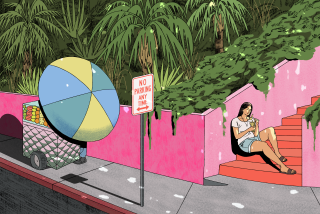BOOK REVIEW : Solving the Case of the Missing Carmens : DOGTOWN <i> by Mercedes Lambert</i> ; Viking; $17.95, 263 pages
- Share via
We’ve got another Los Angeles private detective here: a young woman this time--actually an attorney who’s down on her luck. Whitney Logan, only 25 years old, is stuck between three worlds. From her mother, she’s inherited a value system from the pages of “Town & Country.” Whitney owns three pairs of spectator pumps: black-and-white, blue-and-white, tan-and-white. She often wears her real (opera-length) pearls.
But Whitney also spends part of almost every day down at Gold’s Gym. Whitney’s a bodybuilder. She needs strength, strength to fight against the legacy of her father, who drank incessantly and made fun of her and told her she’d never get through law school.
But she did. And now she drinks. And is not exactly a success in the corporate world. What she has is her independence, her worries about her own sexuality, her pearls, her loneliness, and her third world: L.A. She seems to be living in a new Los Angeles, where you can drive for miles and never see a white person, so entangled now are the strands of all our new immigrant populations.
When a seemingly wealthy matron enters Whitney’s ratty little law office, saying she needs to find her missing Mexican maid, Whitney ponders for an instant or two. Since unfortunate illegal Latinas are a dime a dozen in this town, why is this matron so upset? But because there are no other jobs around, Whitney sets out to find her. And because she doesn’t know word one of Spanish, this plucky attorney enlists the aid of Lupe, a Chicana prostitute who works the street just outside Whitney’s office.
Who says an entertaining, charming, unpretentious detective story can’t be a piece of legitimate agitprop, an authentic agent of social change? Without ever making a big deal of it, the author takes on dozens of issues that define our weird metropolis. Here is Whitney, for instance, thinking about the invisibility of Latin immigrants: “Carmen Luzano . . . I didn’t bother to jot down her description . . . dark skin, five feet tall, shoulder-length black hair. . . . There had to be at least half a million of them. Mexico. Guatemela. Two hundred thousand at a conservative estimate have fled the bloody civil war in El Salvador.”
And later, as Whitney queries some druggie on where she might find this same missing senorita Luzano and the subject of cocaine comes up, our detective wearily reflects: “That is what a Republican Administration is doing to this country. No one’s eating any better or going to school or job-training programs, but now they have cocaine in the ghetto. Rock cocaine. Crack. Pellets the size of peas that will kill you. Cut with PCP sometimes, held together with baking soda or whatever’s handy. The government and organized crime together.”
But the story is the real thing here. There were, it turns out, two Carmen Luzanos, locked in the same (now unfortunately dead) body. One Carmen wanted to help the country of her origin to overthrow dictators, to run guns for good causes. The other Carmen--perhaps even more achingly naive--wanted to become a movie star.
Parallel tracks to these two seemingly separate women take Whitney and her tough, knowledgeable new friend Lupe, into almost every unsavory corner of Strange New L.A.
The unlikely pair work a couple of dance halls--one suave and Korean, the other exotic and Latino. They attend activist revolutionary meetings at the bottom of the Micheltoreno Hill. They indulge in a shootout in the cemetery where Virginia Rappe (Fatty Arbuckle’s unfortunate rape victim) lies buried. And Whitney, at her darkest, most vulnerable moments, worries that she might be attracted to Lupe. (But who, under the L.A. heavens, would not be? Lupe is the perfect sidekick, reality-tester, almost-lover, friend.)
It’s a truism that in novels like this, the city is as much a character as any individual villain or sleuth. Dashiell Hammett’s San Francisco, Raymond Chandler’s Los Angeles, and now Mercedes Lambert’s L.A.--”Dogtown.” This isn’t “just the way we live now,” but where we live and why we live this way.
“Dogtown” is an excellent, fresh, indigenous thriller, and I hope we learn more about Whitney and Lupe. This pair of wonderful private eyes. I have only one question for the author: Whatever happened to Baby Joey? It’s terrible to leave the reader in the dark about a missing kid.
Next: Bettyann Kevles reviews “ In Search of Human Nature “ by Carl N. Degler (Oxford).
More to Read
Sign up for our Book Club newsletter
Get the latest news, events and more from the Los Angeles Times Book Club, and help us get L.A. reading and talking.
You may occasionally receive promotional content from the Los Angeles Times.








